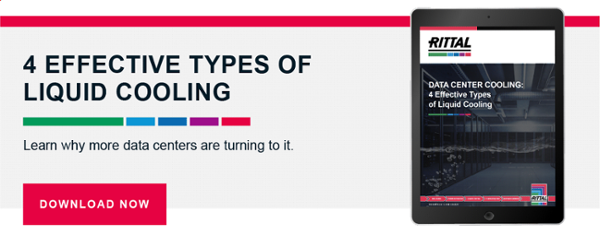The Impressive Impact of IT Enclosures & Cooling on Your DCIM Goals
You can’t improve the overall performance of your data center without a comprehensive data center infrastructure management (DCIM) program in place – a critical tool providing transparency into both your IT equipment and the supporting facility infrastructure (primarily power and cooling). Thoughtfully executed DCIM delivers the insights necessary to optimize your data center’s energy use, asset utilization and performance, and space utilization.
Uptime Institute reports that executing DCIM gives data center operators the ability to:
- Manage logical, physical, and virtual data center assets
- Plan and provision for new equipment
- Make necessary changes in the data center
- Improve the design of the data center
- Increase operational efficiency
- Allow planning for future facility growth
- Maximize the use of existing components
To measure all the data points necessary to realize these benefits, operators rely on DCIM software to measure how well they’re doing against key performance indicators (KPIs). That data is turned into actionable insights that fuel more informed and more reliable decision-making – about everything from the purchase of a new piece of equipment to long-term plans needed to accommodate growing densities.
But, DCIM software is not just about gathering numbers. There must be clearly identified owners of all the data, a team that can not only see lots of values on a screen but be able to take action based on that information. The challenge has been finding the right people to manage the data – is it someone from the facility side, the IT side, both, someone else? The answer is “yes.” OT and IT must collaborate on responding to the information flow; they must be able to see trends, incorporate strategic planning for future growth, maximize available resources and create an environment that can accommodate the ever changing IT space.
These changes could reflect the typical 3 - 4 year technology refresh cycle:
- Add new high density cooling solutions
- Provide higher capacity power to individual footprints, rows or even zones in the IT space
- Use the data to improve performance, whether measuring PUE, DCIE, CADE, server metrics, security metrics, or so many others
The key is look at the data, identify the “low-hanging fruit,” plan for improving efficiencies for the systems in the space (IT and OT), and understand the trends and where they are leading. Mine the data and act upon it.
Keep in mind that this is not a competition; this is information that is used to make sure you have a balanced, well managed and efficient facility – a space that supports your corporate goals, from both the business and operational perspectives...and maybe even save you money.
Depending on the specific software and the unique needs of the data center, there could be dozens of data points measured, many of which are related explicitly or implicitly to enclosures and cooling. Here are 10 of the most common KPIs used to evaluate performance across the data center:
- Available capacity by resource (space, power, cooling, and power/network port connection capacity)
- Energy costs
- Change requests (by user, stage, and type)
- Available cabinet and floor space
- Cabinets with the most free data ports and power ports
- Peak load per cabinet over the past 30 days
- Cabinet power redundancy compliance
- Power usage effectiveness (PUE)
- Cabinet ASHRAE compliance
- Hot spot occurrence and duration
Let’s take a look at how investing in state-of-the-art IT enclosures and cooling can have an immediate, positive impact on several of these KPIs:
Capacity, Cooling, and Energy Use
Data center operators must make the most of the space and cooling capacities available to them, while at the same time ensuring that they’ll be able to accommodate projected future growth. It’s possible to simultaneously maximize space and cooling capacities with the right enclosures (cabinets) and cooling systems.
The best systems, enclosures and climate control available are modular, designed essentially as building blocks that enable staff to add equipment (and equipment of different sizes) easily and to continually take on higher densities as needs evolve. Some offer the flexibility of installing IT equipment in the same cabinet as power, and housing equipment that operates on different feeds. Not only do these features simplify scaling, but make the most of available floor space, too.
Look for modular enclosures that also offer thermal isolation, enabling you to apply different cooling systems within the same space. This capability will reduce energy costs by eliminating the need for separate, dedicated heat removal systems for the different equipment. Starting with the base footprints, add the appropriate thermal management components, with a focus on modularity.
Hot spots within the data hall can also be avoided with the right enclosures and cooling, too. While strategic placement of racks and equipment (spreading high density servers out across the data hall, for example) will help minimize the likelihood of hot spots, liquid cooling solutions deliver the greatest potential to actually eliminate them.
Liquid cooling is more efficient than air-based systems (liquid’s heat-carrying capacity is 3,500X greater than air) because it places cooling much closer to the heat source and reduces air-flow-related needs by 90%. This method can also be used to increase the cooling to specific problem areas in the data center, without having to invest in cooling the entire facility.
Cabinet & Floor Space
Every data center operator today is keeping a close eye on available space so they can answer the question owners will no doubt be asking them: “How will you accommodate the expansion that will be required not just for more servers and racks, but more powerful servers?” A DCIM can only tell an operator how much floor space is available (and its location) and the amount of space available within each enclosure, though; right enclosures and cooling actually helps you maximize what you have. Here are some examples of the features to look for:
- Modular enclosures give operators much-needed agility to easily (and without tools) move and rearrange equipment as needs change; this is especially important when staff is limited
- Some cooling solutions, like Rittal’s closed-loop LCP Rack CW units, feature a compact 12-inch-wide footprint and could double cooling capacity without occupying additional floor space
- Some Rittal models provide zero-U mounting to allow more equipment to be installed in smaller footprints, giving data centers 30% more available mounting space than traditional unibody enclosures
Conclusion
From the IT appliance, through the power distribution, and on to the thermal management, all these systems gather and transmit key operational parameters. With this abundance of data, best-in-class data centers rely on strategic DCIMs to help them overcome the constraints that keep them from operating at peak performance. But the data can only take you so far; for a DCIM to be actionable and effective, the insights that come from data must then be integrated into daily operations. Today’s data centers can achieve more – faster – when leveraging proven technologies and equipment to reach the various capacity, cooling, energy, and space goals that have been outlined in their plan.
Learn more about how to incorporate liquid cooling into your DCIM by reading our 4 Effective Types of Liquid Cooling guide.




